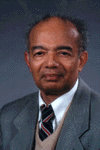 Dr. Y.P.Varshni :
Worked in a number of areas of physics and astrophysics.
Published more than 260 research papers in important scientific
journals. According to Science Citation Index, one of these papers has
been cited 1059 times, another 327 times, and six others 130, 108, 104,
101, 98 and 96 times. Cited in more than 60
books. Dr. Varshni's interests also include the history of
science and he has contributed three biographies to the "Biographical
Encyclopedia of Astronomers".
Research areas include properties of various types of screened potentials
which are used in different areas of physics. Applications of screened potentials
in atomic physics. Properties of an expanding plasma with cooling.
Population inversion and laser action in such plasmas.
X-ray laser.
Applications.
Quasars.
Fellow of the American Physical Society,
Institute of Physics (U.K.), and
Royal Astronomical Society (U.K.).
Full Member of the American Astronomical Society.
Dr. Y.P.Varshni :
Worked in a number of areas of physics and astrophysics.
Published more than 260 research papers in important scientific
journals. According to Science Citation Index, one of these papers has
been cited 1059 times, another 327 times, and six others 130, 108, 104,
101, 98 and 96 times. Cited in more than 60
books. Dr. Varshni's interests also include the history of
science and he has contributed three biographies to the "Biographical
Encyclopedia of Astronomers".
Research areas include properties of various types of screened potentials
which are used in different areas of physics. Applications of screened potentials
in atomic physics. Properties of an expanding plasma with cooling.
Population inversion and laser action in such plasmas.
X-ray laser.
Applications.
Quasars.
Fellow of the American Physical Society,
Institute of Physics (U.K.), and
Royal Astronomical Society (U.K.).
Full Member of the American Astronomical Society.John Talbot : Research associate at the University of Ottawa. Started working with Dr. Varshni in 1994 during his Bachelor of Science honours research project. Background is in quantum mechanics, in particular atomic, plasma and laser physics with applications to astrophysics. Author of the astronomy knowledge base, containing a proposed astronomy Ontology for the semantic web. He is currently working on several astrophysical research projects in close collaboration with Dr. Varshni and is the webmaster of the laser stars web site.



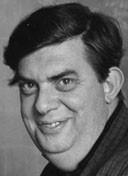
![]()
Dr. Geoffrey Burbidge : Here is a 2 minute portion of a 1983 University of Ottawa lecture
in which Geoffrey Burbidge discusses quasars and recognizes the laser star theory as an alternative quasar theory.
He warns of the fragile foundations upon which the standard cosmological interpretation rests.
Burbidge was Director of the Kitt Peak National Observatory from 1978 to 1984,
served since 1974 as an editor of the Annual Reviews of Astronomy and Astrophysics, and was
President of the Astronomical Society of the Pacific from 1974 to 1976.
He was awarded the American Astronomical Society, Helen Warner Prize, 1959 (with Margaret Burbidge); also the
Indian National Science Academy, Vainu Bappu Memorial Award, 1989; the
National Radio Astronomy Observatory, Jansky Prize, 1985 and the
Royal Astronomical Society, Gold medal, 2005.
![]() Portion of a 1983 lecture by Geoffrey Burbidge (4 MB, MP3, text transcript below) :
Portion of a 1983 lecture by Geoffrey Burbidge (4 MB, MP3, text transcript below) :
|
There is at least one well known physicist, in fact Dr. Varshni, who remains unconvinced that the redshifts are really present. And instead interprets these as lines essentially at rest, lines due to various elements at rest. This changes the whole picture and Dr. Varshni is at one end of a spectrum of argument associated with these questions which I shan't really go into because after all, there is something about redshifts in my title and if say there are no redshifts then I can sit down. So, while I am going to argue about the nature of redshifts and whether they really all will show expansion of the Universe, I am, for the sake of argument at least, starting off on the assumption that we do see redshifts in the spectra of what we then believe are distant objects. If there are no redshifts then of course you understand that this is another way of saying that we don't really know much about the extragalactic Universe, the Universe outside our own galaxy and the immediate vicinity. So, it is a somewhat radical approach and you really have to go back 50 or 60 years and start rethinking a lot of questions. But while while I'm not sure that I would go that far, with Dr. Varshni, I must tell you that much of modern astronomy and particularly extragalactic astronomy and cosmology is really in the form of an inverted pyramid. With a small number of facts at the base of this pyramid on which a large superstructure has been created. And some of this superstructure may indeed fall down, the question of whether it all falls down is a function not only of our understanding of science but also of the sociology of scientists which certainly enters in to these problems. |
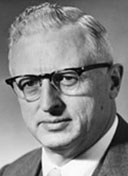 Dr. Donald H. Menzel : Here is a scan of a letter to
Dr. Varshni from the late Donald H.
Menzel, director of the Harvard Observatory (1954-66) who co-wrote
'Principle of Atomic Spectra' (1968),
a graduate-level quantum mechanics textbook which is still cited today. He was
the first astronomer to suggest (1970)
that non-LTE plasmas in a dilute radiation field can produce laser action. He
complained that too many astrophysicist either combine stimulated emission with
the random emission, or neglect it altogether : He proposes the use of the
collisional-radiative plasma model (equation below) to calculate the amount of
population inversion.
Dr. Donald H. Menzel : Here is a scan of a letter to
Dr. Varshni from the late Donald H.
Menzel, director of the Harvard Observatory (1954-66) who co-wrote
'Principle of Atomic Spectra' (1968),
a graduate-level quantum mechanics textbook which is still cited today. He was
the first astronomer to suggest (1970)
that non-LTE plasmas in a dilute radiation field can produce laser action. He
complained that too many astrophysicist either combine stimulated emission with
the random emission, or neglect it altogether : He proposes the use of the
collisional-radiative plasma model (equation below) to calculate the amount of
population inversion.

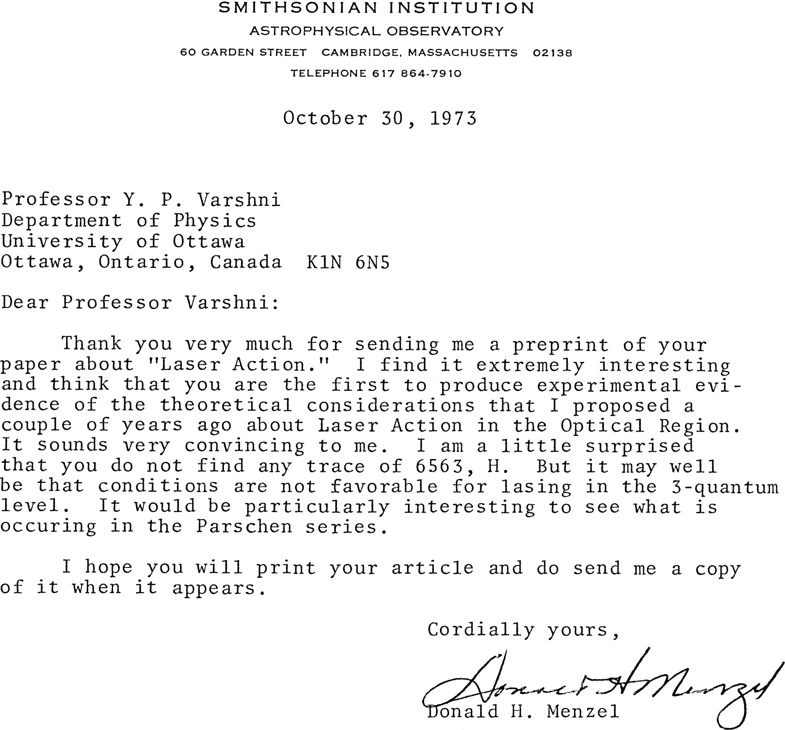
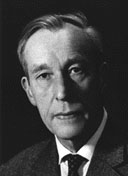 Dr. Bengt EdlÚn : Here is a scan of a letter to Dr. Varshni from the late Bengt EdlÚn.
EdlÚn was a Swedish astrophysicist who resolved the identification of
coronium
emission lines in the solar spectra that had misled scientists for the previous 70 years.
For this discovery EdlÚn received the
1968 Henry Draper Medal
Dr. Bengt EdlÚn : Here is a scan of a letter to Dr. Varshni from the late Bengt EdlÚn.
EdlÚn was a Swedish astrophysicist who resolved the identification of
coronium
emission lines in the solar spectra that had misled scientists for the previous 70 years.
For this discovery EdlÚn received the
1968 Henry Draper Medal

More comments ...
This page updated May 14, 2006